Comparative Insights into the Fundamental Steps Underlying Gelation of Plant and Algal Ionic Polysaccharides: Pectate and Alginate
Abstract
1. Introduction
“Physical gels are characterized by dynamic cross-links that are constantly created and broken, changing its state between solid and liquid under influence of environmental factors. This restructuring ability of physical gels makes them an important class of materials with many applications, such as in drug delivery”.[5]
2. Results and Discussion
2.1. Pectate
2.2. Alginate
2.2.1. Description of the Model
- there is only one type of adsorbate (i.e., Ca2+ ions) and two type of sites with a different affinity for the adsorbate;
- all sites of type i show the same value of the quotient ;
- the bound species attach to definite association sites;
- each site can accommodate only one bound ion;
- there are no interactions between adsorbate molecules on adjacent sites.
- φ1 and φ2 are mutually interdependent;
- φ1 and φ2 will both vary between 0 and 1, thereby being assumed as purely modulating the “intrinsic” binding affinity of type-1 and type-2 sites through Q1 and Q2, respectively;
- sequentially, the type-1 mode of binding is the first to take place, followed by an interconversion to type-2 mode;
- the lowest number of parameters has to be used.
2.2.2. Test of the Model
- (a)
- Pectate
- (b) Alginate
2.3. Comparison
2.3.1. Fractions of Chemically Bound Calcium Counterions
2.3.2. Fractions of Condensed Calcium Counterions with Specific Affinity for Alginate: Evaluation of Their Fractions and of the Corresponding Thermodynamic Parameters
- i
- The affinity process is assumed to derive from desolvation only. The desolvation of both the condensed counterions and the polyion-charged groups is accompanied by positive changes of volume, enthalpy and entropy. The process is supposed to be cratic only, i.e., to stem essentially from the increase of the number of water molecules released from the hydration shells of the interacting ionic species (as to ), with the correlated rupture of several ion/dipole bonds (as to ). The observed positive volume change derives from the decrease of density (i.e., increase of ionic molar volume) of the released water molecules on passing from a condition of electrostriction to that of liquid water. This has been demonstrated by the positive values of the observed molar volume and enthalpy changes in various interactions of divalent ions with both synthetic polycarboxylates [26,27] and with polyuronates [24]. Therefore, both and and and are linearly proportional, i.e.,:
- ii
- The affinity interactions manifesting in the process of desolvation are intrinsically the same for all polyuronates/calcium systems, i (Barclay–Butler relationship [28]), namely they are characterized by a single value of Tm in the equation: . The Barclay–Butler correlation, which has found wide application in thermodynamic hydration studies for a long time, while [29], up to recent times [30], as well as in the thermodynamics of a solution of ionic polysaccharides [31]. On the experimental side, the results of reference [10], herein reported in Figure 8a, strongly support this hypothesis. In fact, they have been obtained in the parallel case of affinity interactions with magnesium ions exhibited by L.hyp. alginate, pectate, and by some related polyuronate systems. The vs. data show a very good linear correlation with a value of the slope as low as 6.8 K.
2.3.3. Calculation of the Molar Enthalpy Changes of Chemically Bound Calcium Counterions
2.3.4. Thermodynamics of the Calcium/Polyuronate Interactions
2.3.5. Macromolecular Properties
3. Conclusions
- Ca2+ counterions are preferentially accumulated as territorially condensed counterions around the polyanions thanks to a “specific affinity” for the carbohydrate polymer moiety;
- such a “cloud” of crowded calcium ions contributes stabilizing the further strong chemical bonding in conformationally specific intermolecular sites, widely known as “egg-boxes”;
- the strong chemical bonding (entailing charge annihilation, albeit not the formation of covalent bonding) develops through two sequential steps. The former one—type-1—involves the formation of an imperfect—or “tilted”—mononuclear egg-box, which upon further calcium ions addition transforms into the sequence of nearest neighboring “perfect” egg-boxes—type-2;
- the change of the molar mass of both pectate and alginate upon increasing concentration of calcium shows that the formation of calcium interchain links starts from the beginning, with no “induction-concentration”, possibly deriving from intramolecular calcium bonding.
- the attainment of the conformational ordering of pectate is the same for both the “tilted” and the ”perfect” egg-box, at variance with alginate, for which such an attainment of conformational order is quite lower for the type-1 mode than that for the type-2 one;
- type-1 bonding mode of alginate is favored with the respect to type-2 for a range of the growing calcium concentration much wider than that of pectate. In both cases, however, the behavior of the linker formation growth perfectly parallels that predicted by the model of Borukhov et al.;
- all thermodynamic parameters of calcium interaction with pectate indicate a stronger affinity in the case of pectate than for alginate.
4. Materials and Methods
| Sample | FG | FM | FGG | FGGG | FGM,MG | FMM | [η] (dL/g) b |
|---|---|---|---|---|---|---|---|
| L. hyperborea alginate | 0.65 | 0.35 | 0.53 | 0.49 | 0.12 | 0.23 | 6.41 ± 0.02 |
| Alginate 1 | 0.45 | 0.55 | 0.30 | n.a. | 0.15 | 0.40 | n.a. |
Author Contributions
Funding
Informed Consent Statement
Conflicts of Interest
Appendix A
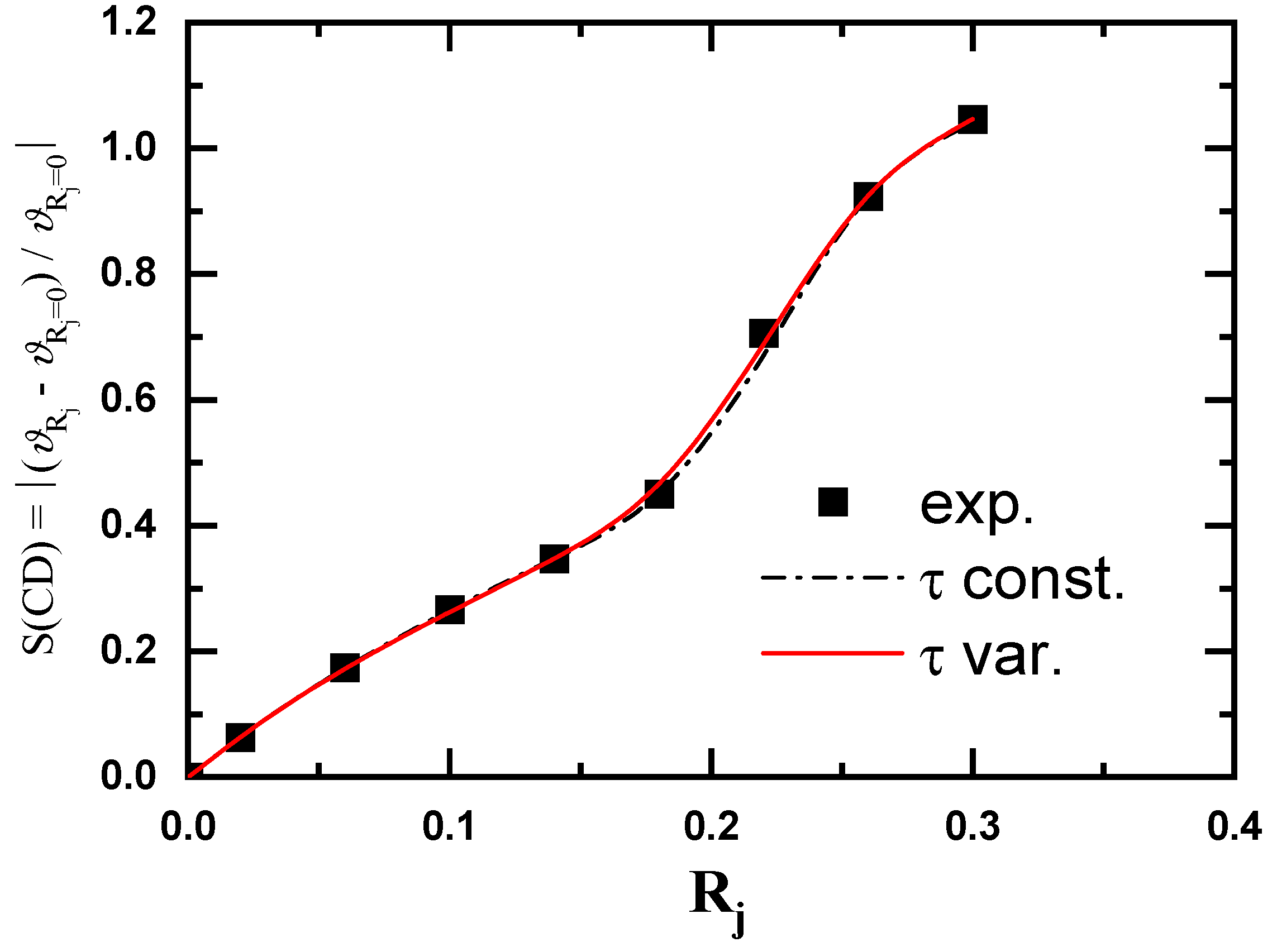
| Parameter | Constant τ | Variable τ |
|---|---|---|
| 1.26 | 1.43 | |
| 1.72 | 2.18 | |
| Q1 | 759 | 640 |
| Q2 | 1488 | 1270 |
| 0.225 | 0.252 | |
| τ | 11.1 | - |
References
- Porath, J. Cross-Linked Dextrans as Molecular Sieves. In Advances in Protein Chemistry; Anfinsen, C.B., Jr., Anson, M.L., Bailey, K., Edsall, J.T., Eds.; Academic Press: Cambridge, MA, USA, 1963; pp. 209–226. [Google Scholar]
- Sannino, A.; Madaghiele, M.; Conversano, F.; Mele, G.; Maffezzoli, A.; Netti, P.A.; Ambrosio, L.; Nicolais, L. Cellulose Derivative−Hyaluronic Acid-Based Microporous Hydrogels Cross-Linked through Divinyl Sulfone (DVS) To Modulate Equilibrium Sorption Capacity and Network Stability. Biomacromolecules 2004, 5, 92–96. [Google Scholar] [CrossRef] [PubMed]
- Lenzi, F.; Sannino, A.; Borriello, A.; Porro, F.; Capitani, D.; Mensitieri, G. Probing the degree of crosslinking of a cellulose based superabsorbing hydrogel through traditional and NMR techniques. Polymer 2003, 44, 1577–1588. [Google Scholar] [CrossRef]
- Research Reports World. Global Polysaccharides Market Size and Value Expected to Reach USD 3250 Million|Growing at CAGR of 5.32%|Forecast Period 2022–2027. 2022. Available online: https://www.marketwatch.com/press-release/global-polysaccharides-market-size-and-value-expected-to-reach-usd-3250-million-growing-at-cagr-of-532-forecast-period-2022-2027-2022-10-04 (accessed on 26 October 2022).
- An, Y.; Solis, F.J.; Jiang, H. A thermodynamic model of physical gels. J. Mech. Phys. Solids 2010, 58, 2083–2099. [Google Scholar] [CrossRef]
- Celus, M.; Kyomugasho, C.; van Loey, A.M.; Grauwet, T.; Hendrickx, M.E. Influence of Pectin Structural Properties on Interactions with Divalent Cations and Its Associated Functionalities. Compr. Rev. Food Sci. Food Saf. 2018, 17, 1576–1594. [Google Scholar] [CrossRef] [PubMed]
- Thakur, B.R.; Singh, R.K.; Handa, A.K.; Rao, M.A. Chemistry and uses of pectin—A review. Crit. Rev. Food Sci. Nutr. 1997, 37, 47–73. [Google Scholar] [CrossRef] [PubMed]
- Donati, I.; Paoletti, S. Material Properties of Alginates. In Alginates: Biology and Applications; Rehm, B.H.A., Ed.; Springer: Berlin/Heildelberg, Germany, 2009; pp. 1–53. [Google Scholar]
- Donati, I.; Benegas, J.C.; Cesàro, A.; Paoletti, S. Specific interactions versus counterion condensation. 2. Theoretical treatment within the counterion condensation theory. Biomacromolecules 2006, 7, 1587–1596. [Google Scholar] [CrossRef]
- Donati, I.; Cesàro, A.; Paoletti, S. Specific interactions versus counterion condensation. 1. Nongelling ions/polyuronate systems. Biomacromolecules 2006, 7, 281–287. [Google Scholar] [CrossRef]
- Donati, I.; Benegas, J.; Paoletti, S. On the Molecular Mechanism of the Calcium-Induced Gelation of Pectate. Different Steps in the Binding of Calcium Ions by Pectate. Biomacromolecules 2021, 22, 5000–5019. [Google Scholar] [CrossRef]
- Donati, I.; Benegas, J.C.; Paoletti, S. Polyelectrolyte study of the calcium-induced chain association of pectate. Biomacromolecules 2006, 7, 3439–3447. [Google Scholar] [CrossRef]
- Manning, G.S. Limiting Laws and Counterion Condensation in Polyelectrolyte Solutions I. Colligative Properties. J. Chem. Phys. 1969, 51, 924–933. [Google Scholar] [CrossRef]
- Manning, G.S. Limiting laws and counterion condensation in polyelectrolyte solutions: V. Further development of the chemical model. Biophys. Chem. 1978, 9, 65–70. [Google Scholar] [CrossRef]
- Paoletti, S.; Benegas, J.; Cesàro, A.; Manzini, G.; Fogolari, F.; Crescenzi, V. Limiting-laws of polyelectrolyte solutions. Ionic distribution in mixed-valency counterions systems. I: The model. Biophys. Chem. 1991, 41, 73–80. [Google Scholar] [CrossRef]
- Antonio, M.R.; Nyman, M.; Anderson, T.M. Direct Observation of Contact Ion-Pair Formation in Aqueous Solution. Angew. Chemie Int. Ed. 2009, 48, 6136–6140. [Google Scholar] [CrossRef]
- Spiro, T.G.; Revesz, A.; Lee, J. Volume changes in ion association reactions. Inner- and outer-sphere complexes. J. Am. Chem. Soc. 1968, 90, 4000–4006. [Google Scholar] [CrossRef]
- Borgogna, M.; Skjåk-Bræk, G.; Paoletti, S.; Donati, I. On the initial binding of alginate by calcium ions. the tilted egg-box hypothesis. J. Phys. Chem. B. 2013, 117, 7277–7282. [Google Scholar] [CrossRef]
- Grant, G.T.; Morris, E.R.; Rees, D.A.; Smith, P.J.C.; Thom, D. Biological interactions between polysaccharides and divalent cations: The egg-box model. FEBS Lett. 1973, 32, 195–198. [Google Scholar] [CrossRef]
- Braccini, I.; Pérez, S. Molecular Basis of Ca2+-Induced Gelation in Alginates and Pectins: The Egg-Box Model Revisited. Biomacromolecules 2001, 2, 1089–1096. [Google Scholar] [CrossRef]
- Sikorski, P.; Mo, F.; Skjåk-Bræk, G.; Stokke, B.T. Evidence for Egg-Box-Compatible Interactions in Calcium−Alginate Gels from Fiber X-ray Diffraction. Biomacromolecules 2007, 8, 2098–2103. [Google Scholar] [CrossRef]
- Borukhov, I.; Lee, K.-C.; Bruinsma, R.F.; Gelbart, W.M.; Liu, A.J.; Stevens, M.J. Association of two semiflexible polyelectrolytes by interchain linkers: Theory and simulations. J. Chem. Phys. 2002, 117, 462–480. [Google Scholar] [CrossRef]
- Kohn, R. Ion binding on polyuronates-alginate and pectin. Pure Appl. Chem. 1975, 42, 371–397. [Google Scholar] [CrossRef]
- Cesàro, A.; Delben, F.; Paoletti, S. Interaction of divalent cations with polyuronates. J. Chem. Soc. Faraday Trans. 1 Phys. Chem. Condens. Phases 1988, 84, 2573–2584. [Google Scholar] [CrossRef]
- Paoletti, S.; Delben, F.; Cesaro, A.; Grasdalen, H. Conformational transition of .kappa.-carrageenan in aqueous solution. Macromolecules 1985, 18, 1834–1841. [Google Scholar] [CrossRef]
- Paoletti, S.; Delben, F.; Crescenzi, V. Thermodynamics of polycarboxylate aqueous solutions. 3. Binding of divalent ions. J. Phys. Chem. 1976, 80, 2564–2568. [Google Scholar] [CrossRef]
- Strauss, U.P.; Leung, Y.P. Volume Changes as a Criterion for Site Binding of Counterions by Polyelectrolytes. J. Am. Chem. Soc. 1965, 87, 1476–1480. [Google Scholar] [CrossRef]
- Barclay, I.M.; Butler, J.A.V. The entropy of solution. Trans. Faraday Soc. 1938, 34, 1445–1454. [Google Scholar] [CrossRef]
- Manche, E.P.; Carroll, B. The kinetic isotope effect in dehydration of ionic solids. 2. The kinetics of dehydration of calcium oxalate monohydrate. J. Phys. Chem. 1977, 81, 2637–2639. [Google Scholar] [CrossRef]
- Maki, H.; Sogawa, R.; Fukui, M.; Deki, S.; Mizuhata, M. Quantitative Analysis of Water Activity Related to Hydration Structure in Highly Concentrated Aqueous Electrolyte Solutions. Electrochemistry 2019, 87, 139–141. [Google Scholar] [CrossRef]
- Paoletti, S.; Benegas, J.C.; Pantano, S.; Vetere, A. Thermodynamics of the conformational transition of biopolyelectrolytes: The case of specific affinity of counterions. Biopolymers 1999, 50, 705–719. [Google Scholar] [CrossRef]
- Atkins, E.D.T.; Nieduszynski, I.A.; Mackie, W.; Parker, K.D.; Smolko, E.E. Structural components of alginic acid. II. The crystalline structure of poly-α-L-guluronic acid. Results of X-ray diffraction and polarized infrared studies. Biopolymers 1973, 12, 1879–1887. [Google Scholar] [CrossRef]
- Thibault, J.-F.; Rinaudo, M. Gelation of pectinic acids in the presence of calcium counterions. Br. Polym. J. 1985, 17, 181–184. [Google Scholar] [CrossRef]
- Thibault, J.F.; Rinaudo, M. Chain association of pectic molecules during calcium-induced gelation. Biopolymers 1986, 25, 455–468. [Google Scholar] [CrossRef]
- Fang, Y.; Al-Assaf, S.; Phillips, G.O.; Nishinari, K.; Funami, T.; Williams, P.A.; Li, L. Multiple Steps and Critical Behaviors of the Binding of Calcium to Alginate. J. Phys. Chem. B. 2007, 111, 2456–2462. [Google Scholar] [CrossRef]
- Fang, Y.; Al-Assaf, S.; Phillips, G.O.; Nishinari, K.; Funami, T.; Williams, P.A. Binding behavior of calcium to polyuronates: Comparison of pectin with alginate. Carbohydr. Polym. 2008, 72, 334–341. [Google Scholar] [CrossRef]
- Odijk, T. Polyelectrolytes near the rod limit. J. Polym. Sci. Polym. Phys. Ed. 1977, 15, 477–483. [Google Scholar] [CrossRef]
- Smidsrød, O.; Haug, A. Estimation of the relative stiffness of the molecular chain in polyelectrolytes from measurements of viscosity at different ionic strengths. Biopolymers 1971, 10, 1213–1227. [Google Scholar] [CrossRef]
- Paoletti, S.; Cesàro, A.; Delben, F.; Ciana, A. Ionic Effects on the Conformation, Equilibrium, Properties, and Rheology of Pectate in Aqueous Solutions and Gels. In Chemistry and Function of Pectins; ACS Symposium Series Vol. 310; American Chemical Society: Washington, DC, USA, 1986; Chapter 7; pp. 7–73. [Google Scholar]
- Cesàro, A.; Ciana, A.; Delben, F.; Manzini, G.; Paoletti, S. Physicochemical properties of pectic acid. I. Thermodynamic evidence of a pH-induced conformational transition in aqueous solution. Biopolymers 1982, 21, 431–449. [Google Scholar] [CrossRef]
- Delben, F.; Cesaro, À.; Paoletti, S.; Crescenzi, V. Monomer composition and acetyl content as main determinants of the ionization behavior of alginates. Carbohydr. Res. 1982, 100, C46–C50. [Google Scholar] [CrossRef]
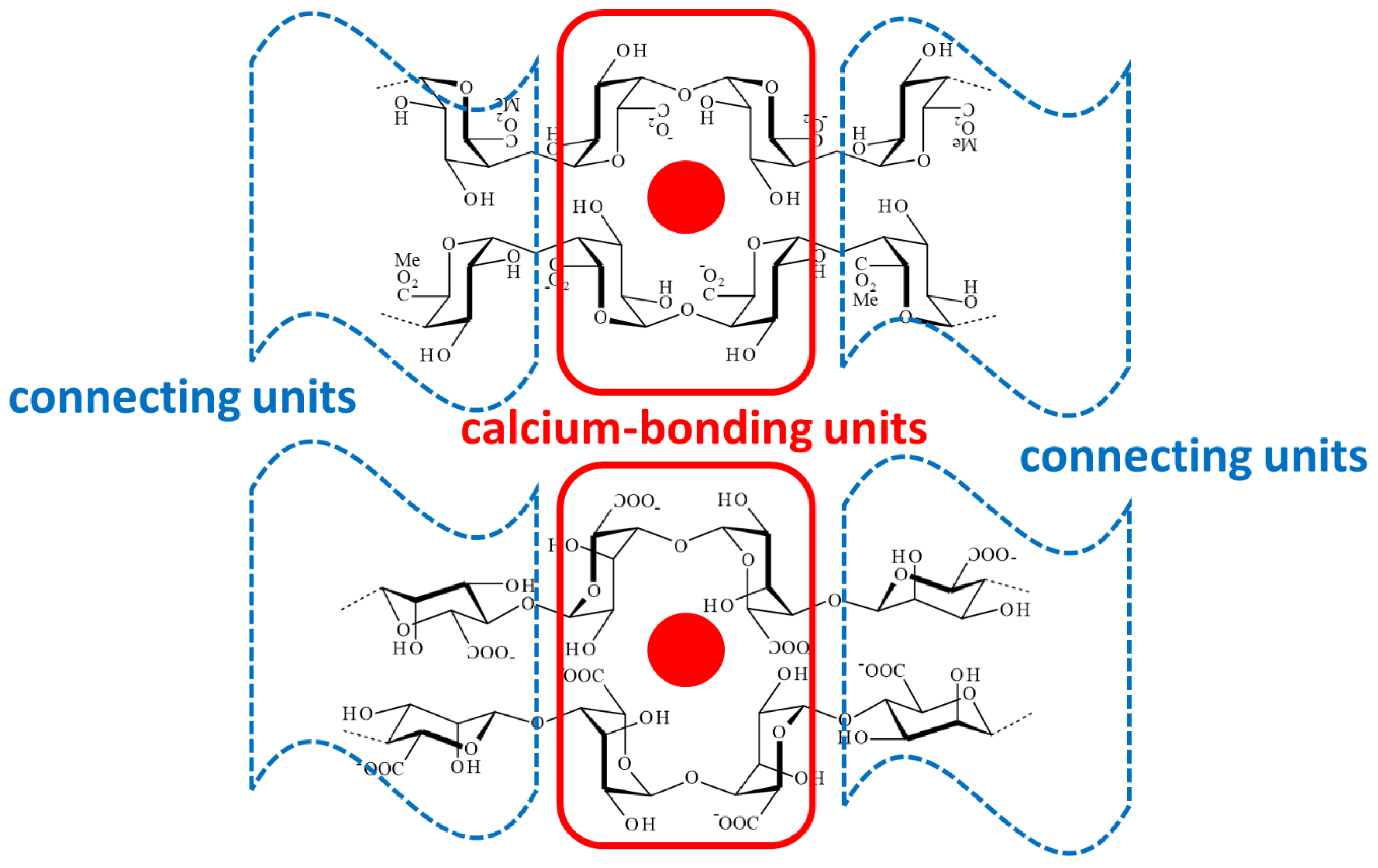


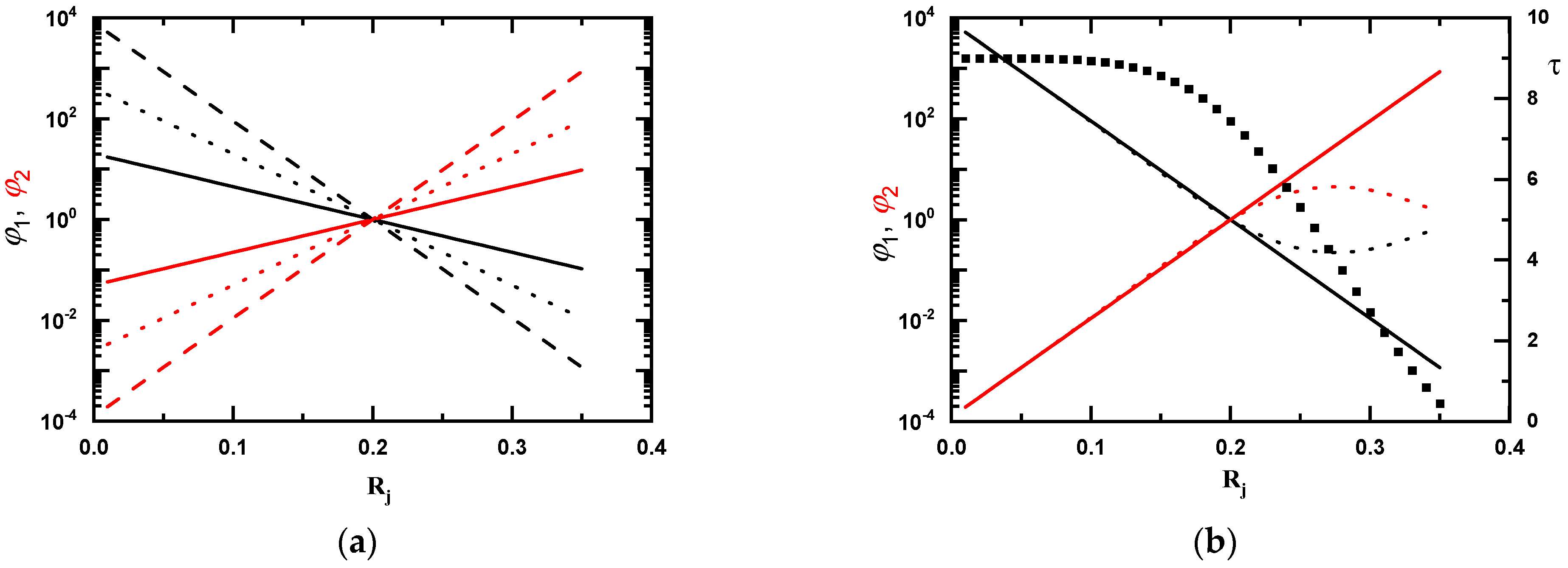
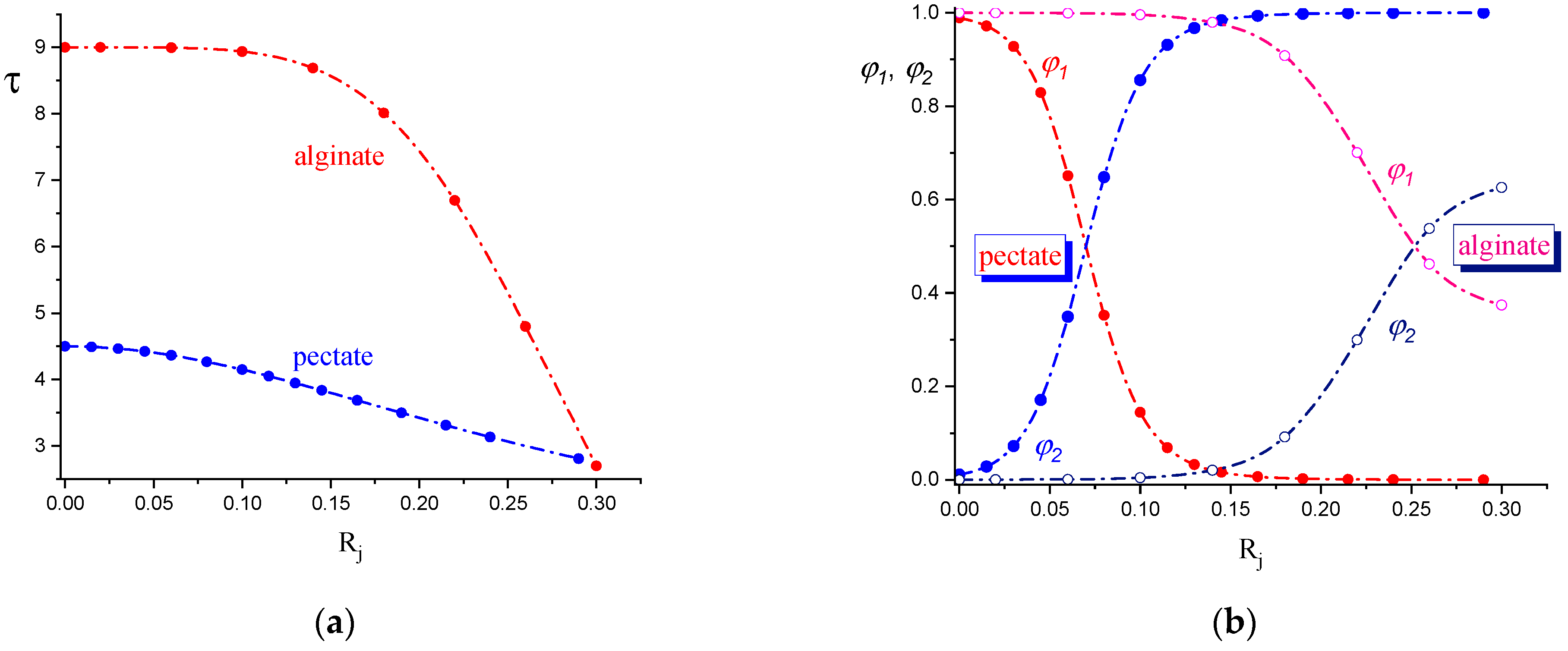

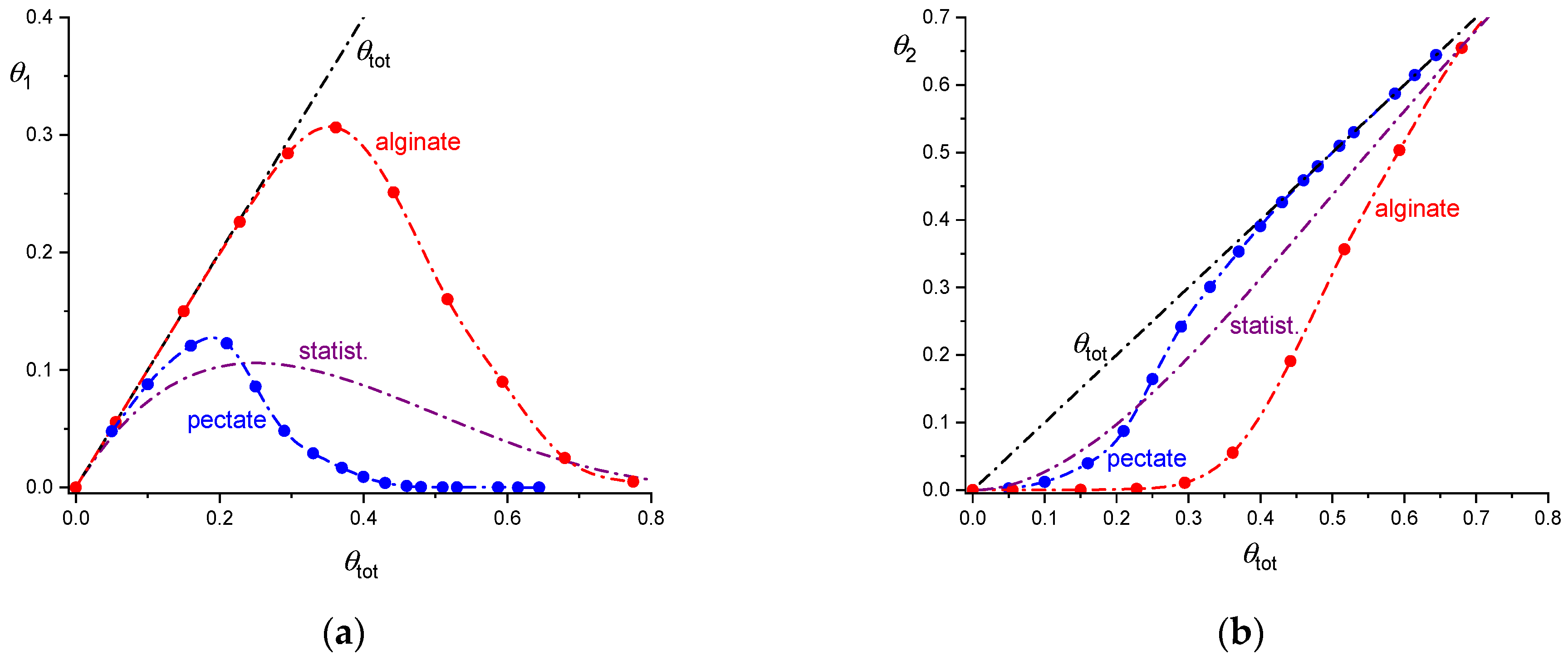
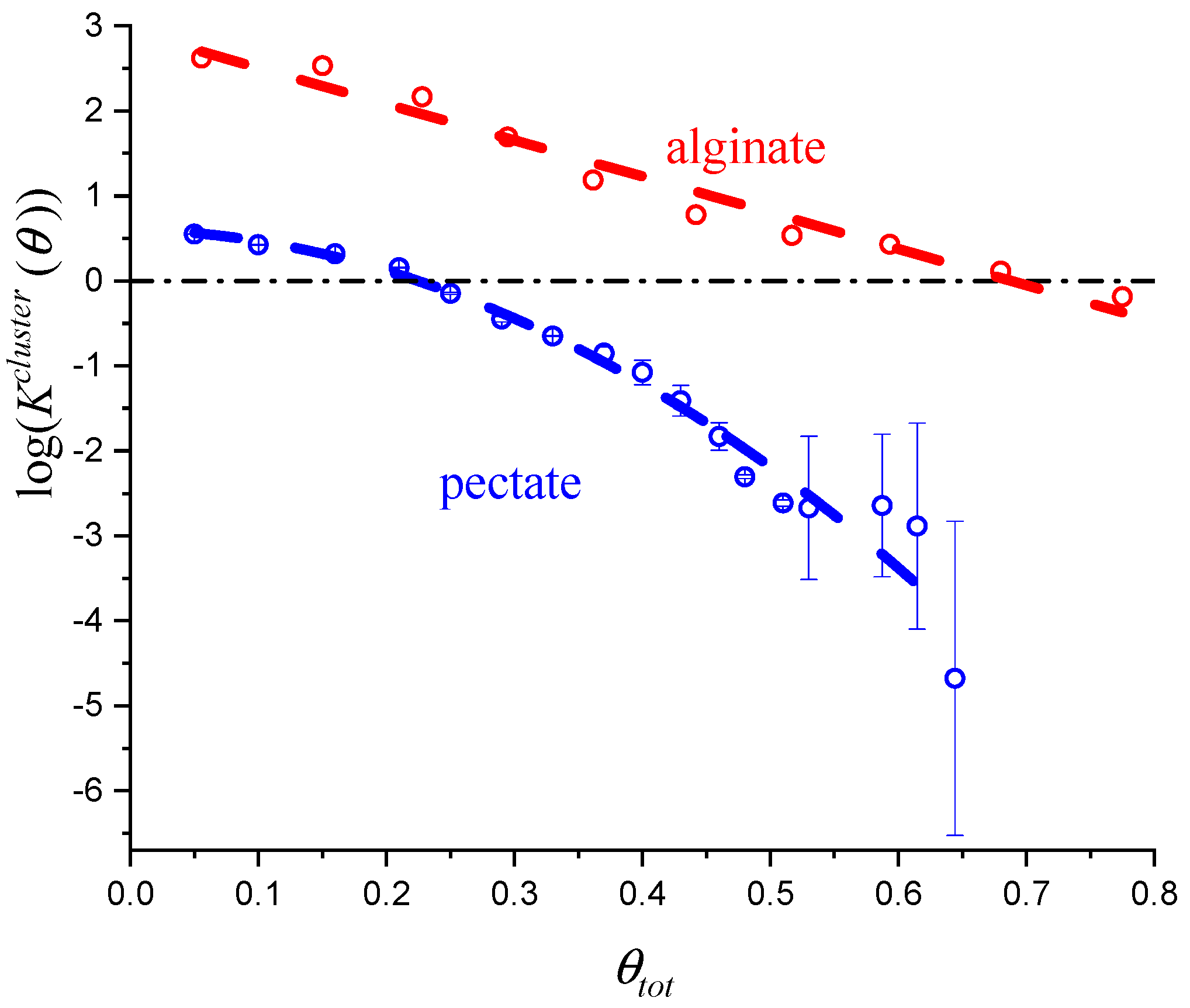
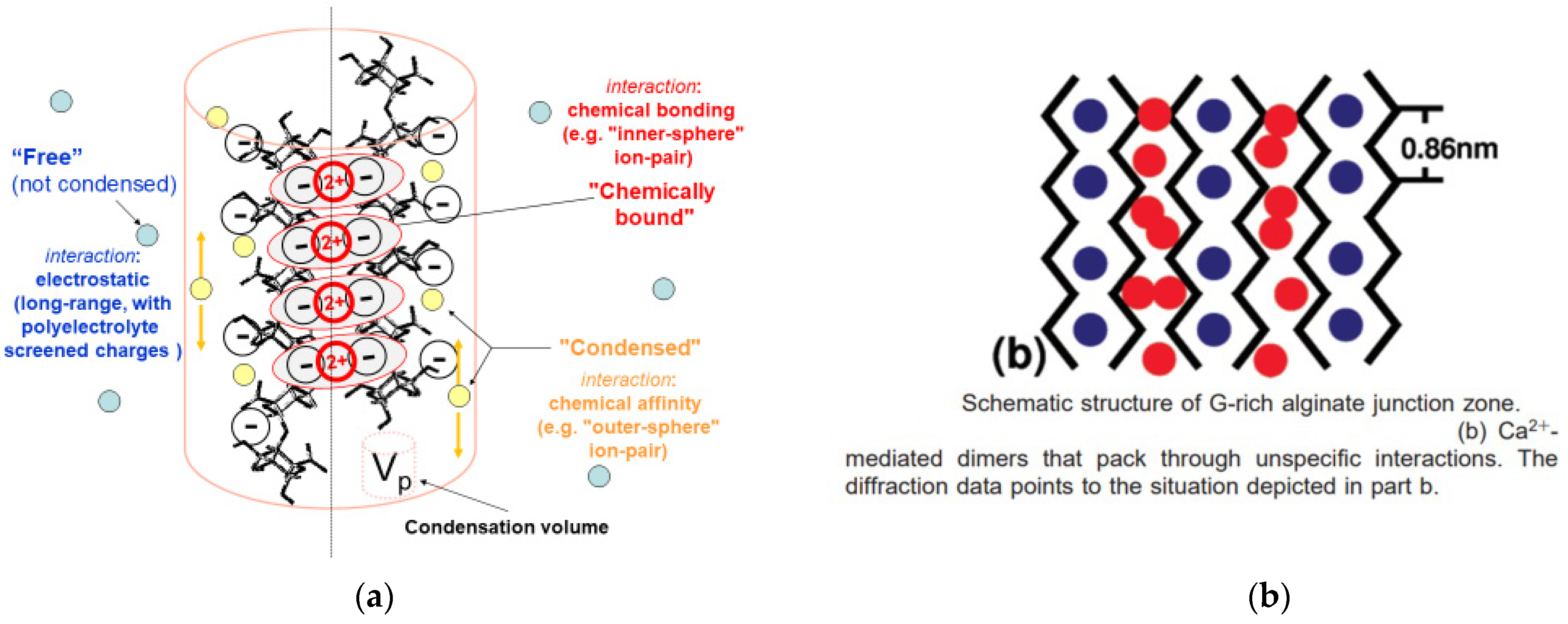
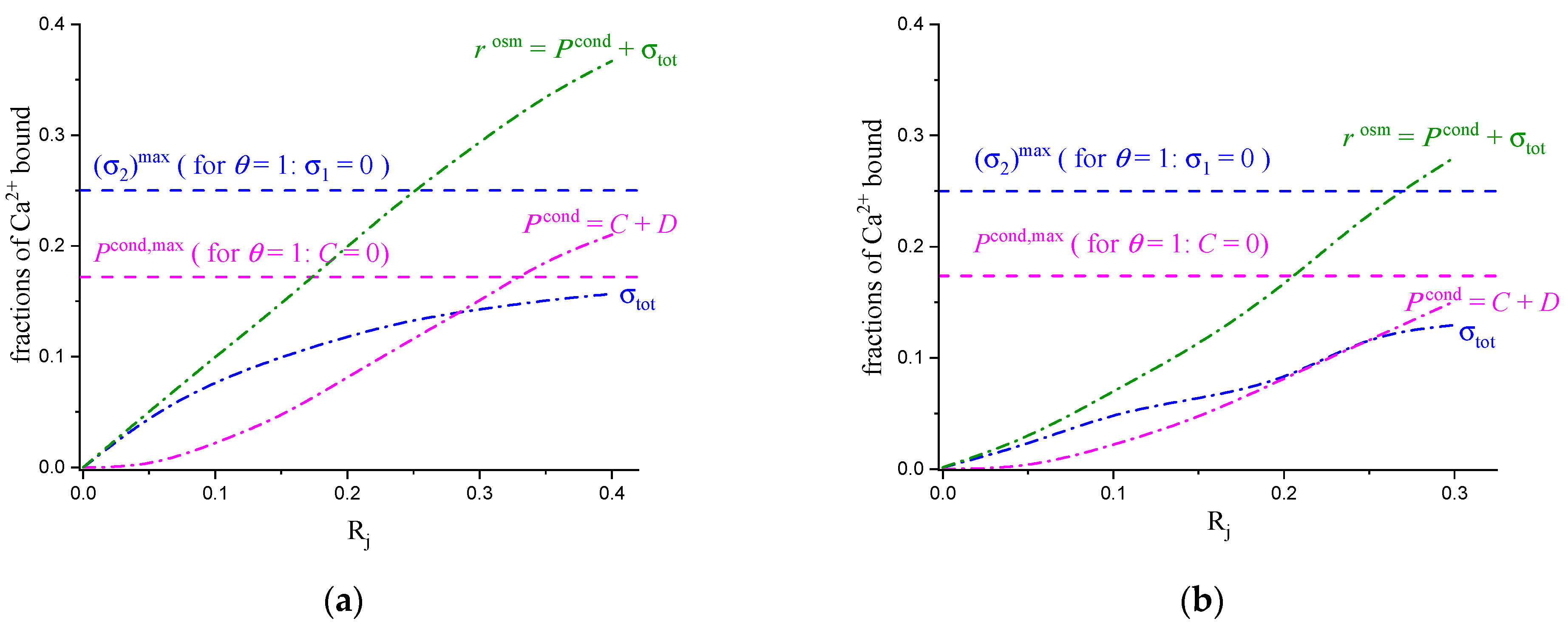
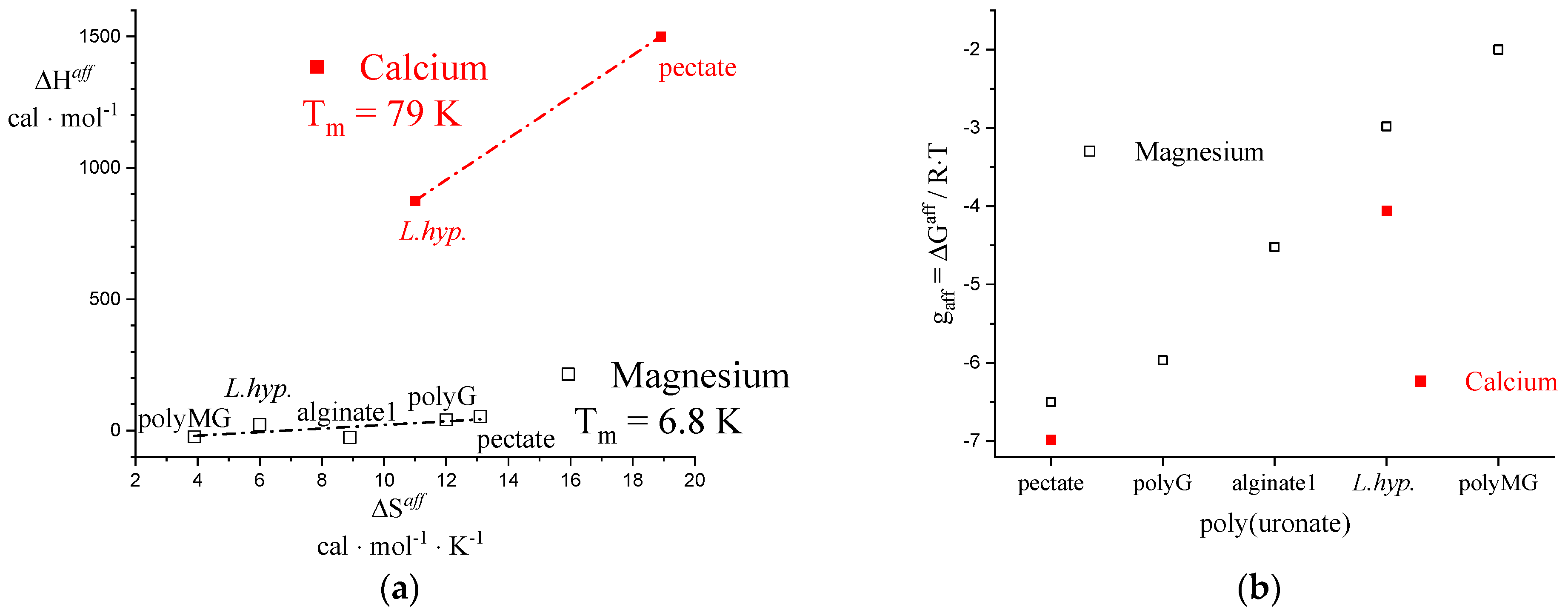
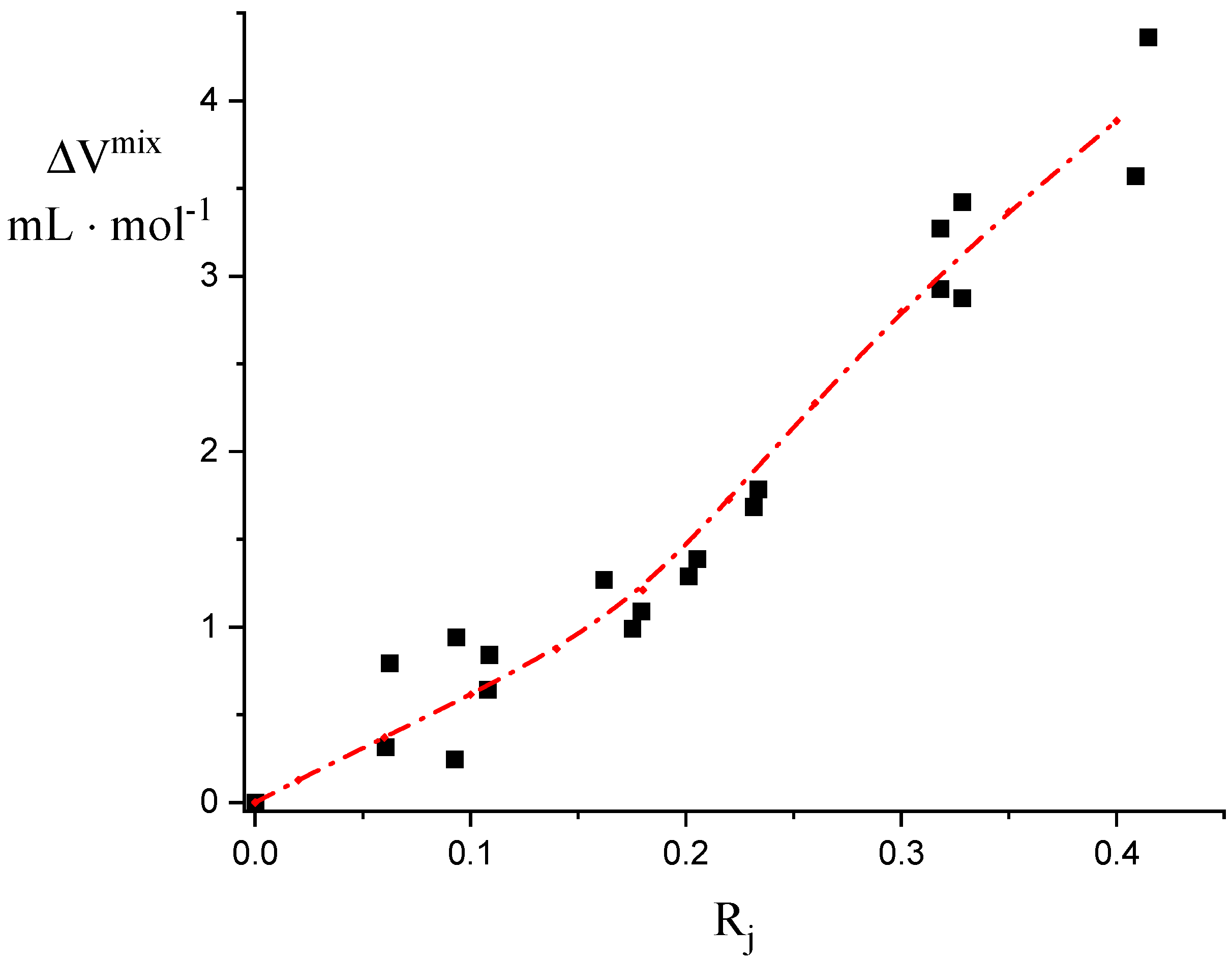
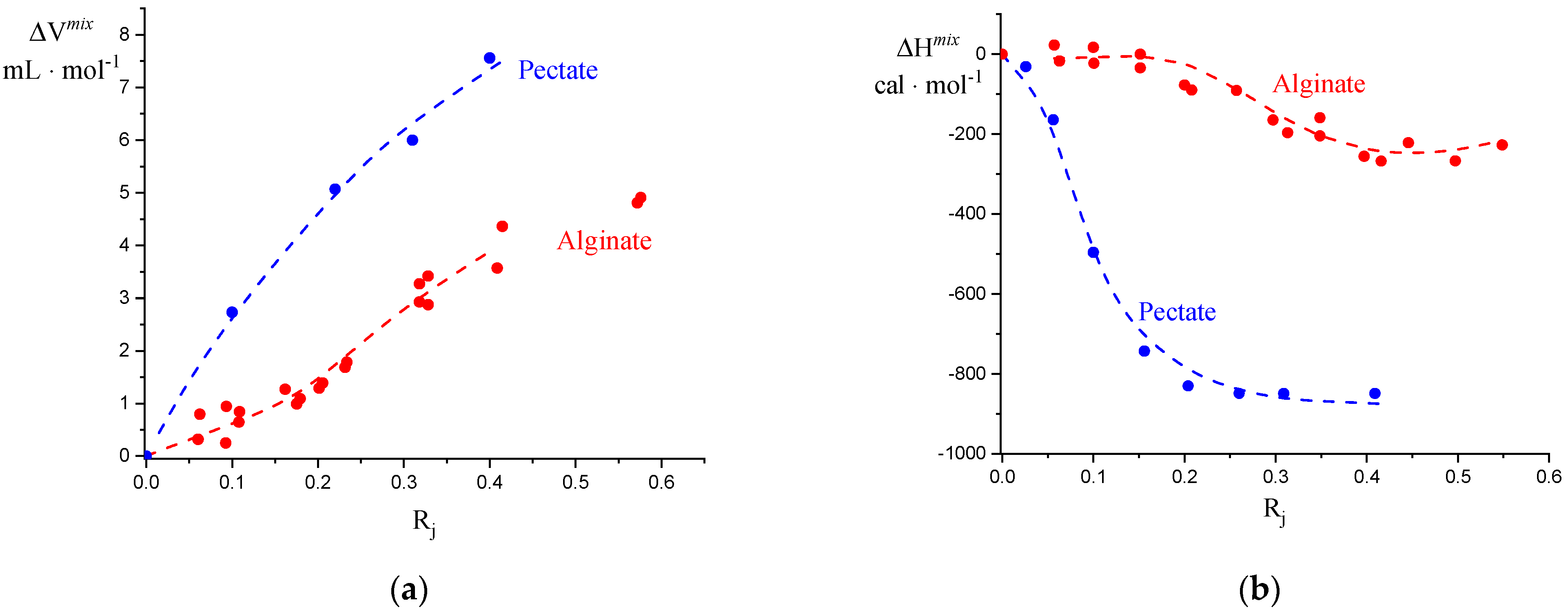



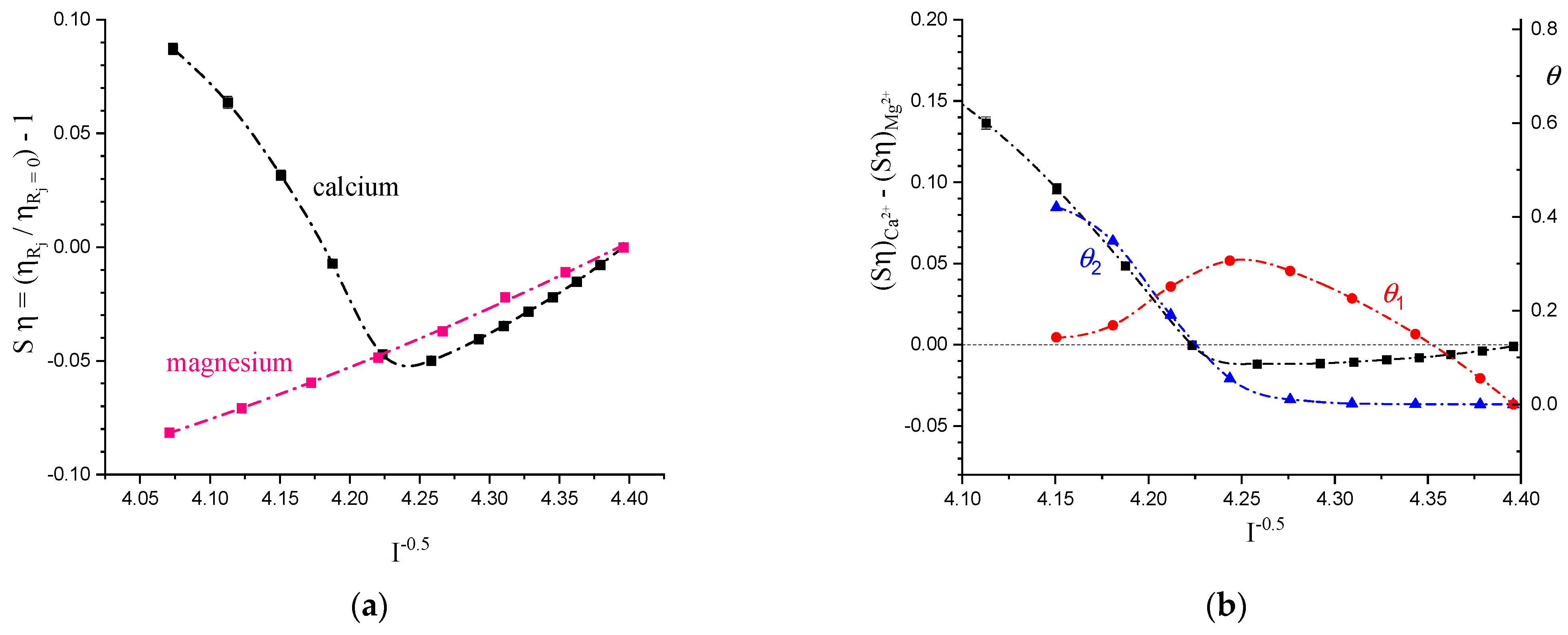
| Pectate | Alginate | |||
|---|---|---|---|---|
| A. Affinity | ||||
| 12 | mL·mol−1 | 7 | ||
| 18.9 | cal·mol−1 K−1 | 11.0 | ||
| 1500 | cal·mol−1 | 875 | ||
| −4135 | cal·mol−1 | −2411 | ||
| gaff | −7.0 | (gaff = | gaff | −4.1 |
| B. Bonding | ||||
| 29 | mL·mol−1 | 9 | ||
| ΔA[𝜗] | 1.00 | - | ΔA[𝜗] | 1.43 |
| 29 | mL·mol−1 | 15 | ||
| ΔB[𝜗] | 1.00 | - | ΔB[𝜗] | 2.18 |
| −1704 | cal·mol−1 | −750 | ||
| −7817 | cal·mol−1 | −2100 | ||
| For | And | Then | |||||
|---|---|---|---|---|---|---|---|
| = | Finite value | 1/2 | 1/2 | ||||
| = | 0 | → | ∞ | 1 | 0 | ||
| = | 0 | = | 0 | 1/2 | 1/2 | ||
| = | 0 | → | - ∞ | 0 | 1 | ||
| → | ∞ | Finite value | 0 | 1 | |||
Publisher’s Note: MDPI stays neutral with regard to jurisdictional claims in published maps and institutional affiliations. |
© 2022 by the authors. Licensee MDPI, Basel, Switzerland. This article is an open access article distributed under the terms and conditions of the Creative Commons Attribution (CC BY) license (https://creativecommons.org/licenses/by/4.0/).
Share and Cite
Paoletti, S.; Donati, I. Comparative Insights into the Fundamental Steps Underlying Gelation of Plant and Algal Ionic Polysaccharides: Pectate and Alginate. Gels 2022, 8, 784. https://doi.org/10.3390/gels8120784
Paoletti S, Donati I. Comparative Insights into the Fundamental Steps Underlying Gelation of Plant and Algal Ionic Polysaccharides: Pectate and Alginate. Gels. 2022; 8(12):784. https://doi.org/10.3390/gels8120784
Chicago/Turabian StylePaoletti, Sergio, and Ivan Donati. 2022. "Comparative Insights into the Fundamental Steps Underlying Gelation of Plant and Algal Ionic Polysaccharides: Pectate and Alginate" Gels 8, no. 12: 784. https://doi.org/10.3390/gels8120784
APA StylePaoletti, S., & Donati, I. (2022). Comparative Insights into the Fundamental Steps Underlying Gelation of Plant and Algal Ionic Polysaccharides: Pectate and Alginate. Gels, 8(12), 784. https://doi.org/10.3390/gels8120784









